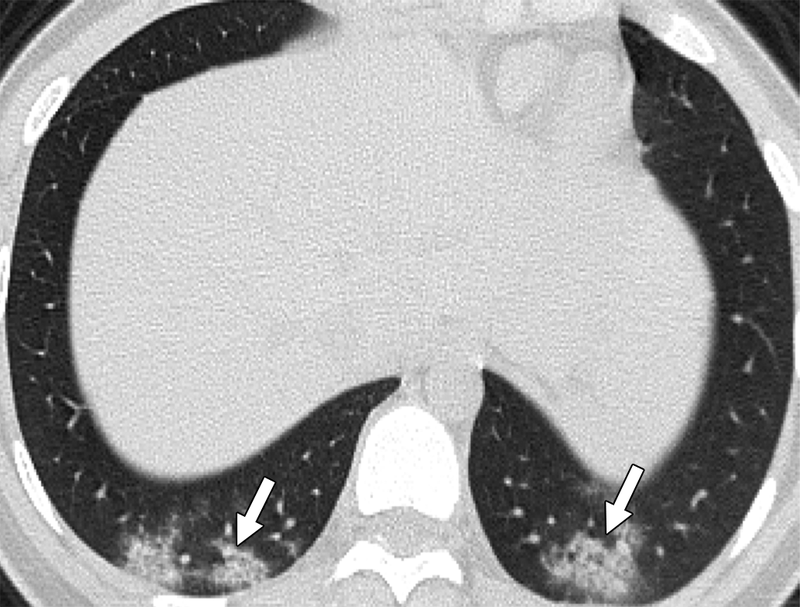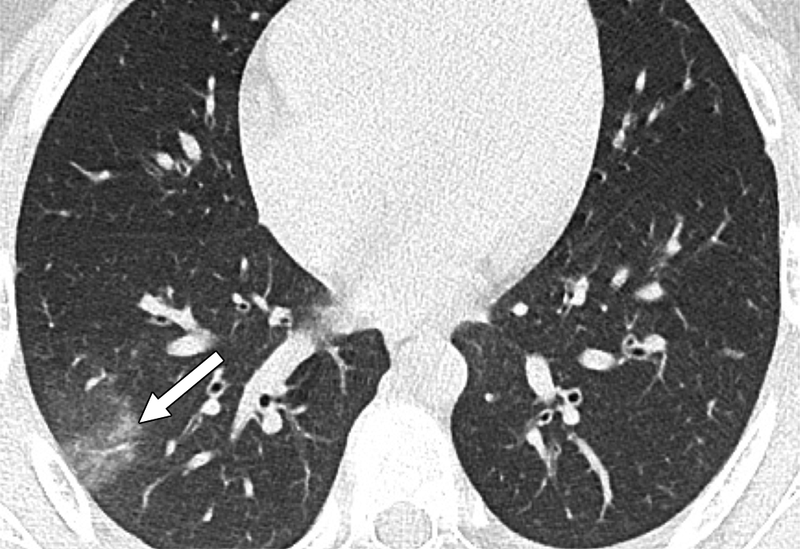Most COVID-19-Positive Children Have Negative Chest CT Scans
Research shows 77 percent of children who are confirmed positive for the virus have no findings via chest CT.

8-year-old boy with coronavirus disease. A, Unenhanced chest CT scans show minimal ground-glass opacities (in right lower and left upper lobes) (arrows) and no consolidation. Only two lobes were affected, and CT findings were assigned CT severity score of 2. Courtesy: American Journal of Roentgenology

Most children who are confirmed positive for COVID-19 with the RT-PCR test have chest CT scans that show no findings of viral infection, according to newly published research.
In the American Journal of Roentgenology, a research team, led by Sharon Steinberger, M.D., cardiothoracic imaging fellow at Icahn School of Medicine at Mount Sinai, revealed that 77 percent of children who have laboratory-confirmed disease also have negative chest CT scans. These findings cast doubt on the true usefulness of these images in identifying and managing patients positive for viral infection.
“Our early study investigating pediatric patients with known infection raises questions about the widespread utilization of chest CT in children,” the team wrote, noting this study is the largest series to date that describes imaging findings in children. “Our findings show the limited sensitivity and poor negative predictive value of chest CT for the detection of suspected COVID-19 in children and highlight that normal chest CT findings do not exclude disease.”
Currently, children – patients ages 18 and under – account for 2 percent of reported cases, and they present with milder symptoms than adults. In fact, 30 percent of the cohort had no clinical symptoms at the time of diagnosis, making their cases simultaneously harder to recognize and more critical to diagnose. The team did discover that older children had more severe CT scores.
To determine the efficacy and reliability of chest CT scans in children with suspected viral infection, Steinberger’s team analyzed images from 30 pediatric patients between the ages of 10 months and 18 years who had RT-PCR-positive test results. The children were treated in six hospitals in China between Jan. 23, 2020, and Feb. 8, 2020. All remained in stable condition during their hospitalization.
The Results
Based on the study analysis, 23 patients – 77 percent – had normal CT findings with no evidence of ground-glass opacities or consolidation. Among the seven who had abnormal scans, six (86 percent) had ground-glass opacities alone, and one had ground-glass opacities and consolidation. Crazy waving pattern, reverse halo sign, and halo sign were identified in two patients each (29 percent). In addition, six patients also had peripheral lung distribution.
Lower lobes were most commonly involved, affecting six of the seven patients, and most (71 percent) had bilateral disease. Two (29 percent) had opacities in one lobe; three (43 percent) in two lobes; one (14 percent) in three lobes; and one in four lobes.
Follow-up scans did not improve CT performance, the team said. Ten out of 11 patients scanned again showed no change in their findings.
What It Means
The high inaccuracy rate of the scans, coupled with the fact that these findings are not specific to COVID-19, should give providers pause about the actual diagnostic and disease management utility of the images, the team said.
“For children with suspected infection, but without suspicion of complication, in light of the low sensitivity of CT, its benefits may not outweigh the potential harm of radiation exposure,” the team said. “However, when these findings are encountered in a pediatric patient who has a suspicious clinical history or lives in an area with a high prevalence of COVID-19, they should alert the radiologist to consider a diagnosis of COVID-19.”
Providers should also consider the lower incidence of severe disease in children when deciding whether to order a chest CT, they said. It is important to note, though, that CT can be used to effectively assess possible complications, including other infections, pulmonary emboli, or other pre-existing conditions that might be negatively impacted by the virus.
Ultimately, they said, even though more research is needed to fully elucidate clinical symptoms and imaging findings associated with COVID-19, their findings highlight the need for radiologists to understand how COVID-19 affects the pediatric population.
“Recognizing the common CT pattern and distribution of findings of COVID-19 in children is crucial for prompt isolation and disease containment. Although children had milder symptoms overall, severe cases do occur in the pediatric population, and deaths have been reported,” the team said. “Identifying these patterns and signs can help radiologists to distinguish COVID-19 pneumonia from other diseases.”
Study with CT Data Suggests Women with PE Have More Than Triple the One-Year Mortality Rate than Men
April 3rd 2025After a multivariable assessment including age and comorbidities, women with pulmonary embolism (PE) had a 48 percent higher risk of one-year mortality than men with PE, according to a new study involving over 33,000 patients.
The Reading Room: Racial and Ethnic Minorities, Cancer Screenings, and COVID-19
November 3rd 2020In this podcast episode, Dr. Shalom Kalnicki, from Montefiore and Albert Einstein College of Medicine, discusses the disparities minority patients face with cancer screenings and what can be done to increase access during the pandemic.
Predicting Diabetes on CT Scans: What New Research Reveals with Pancreatic Imaging Biomarkers
March 25th 2025Attenuation-based biomarkers on computed tomography (CT) scans demonstrated a 93 percent interclass correlation coefficient (ICC) agreement across three pancreatic segmentation algorithms for predicting diabetes, according to a study involving over 9,700 patients.
Can Photon-Counting CT be an Alternative to MRI for Assessing Liver Fat Fraction?
March 21st 2025Photon-counting CT fat fraction evaluation offered a maximum sensitivity of 81 percent for detecting steatosis and had a 91 percent ICC agreement with MRI proton density fat fraction assessment, according to new prospective research.